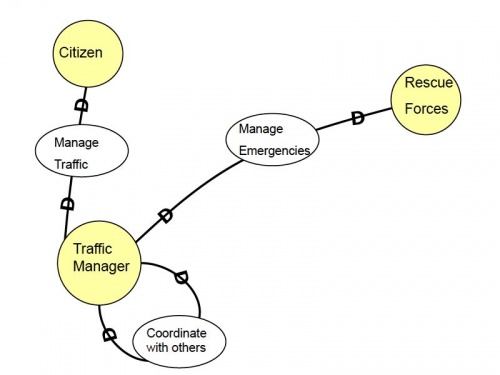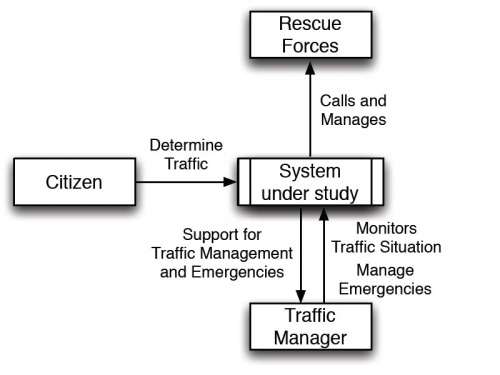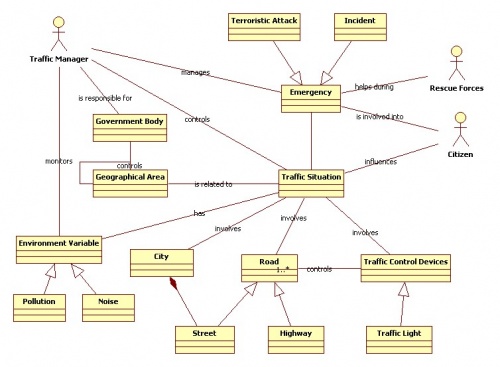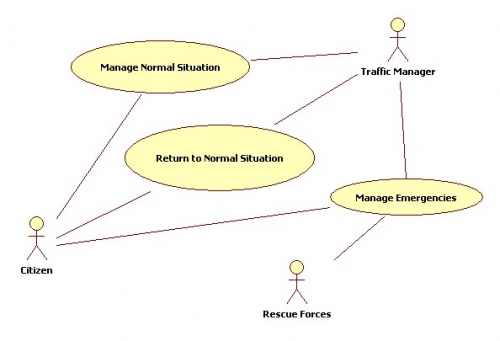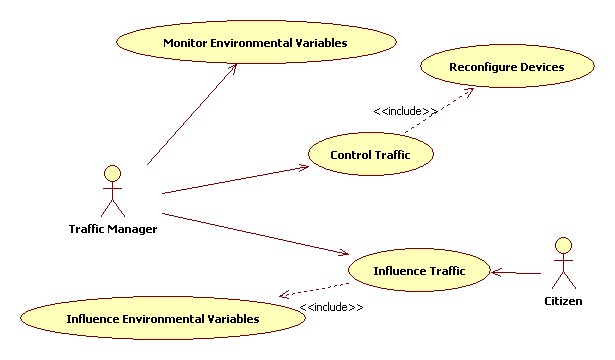Traffic Case Study
Contents
Description
This case study describes a traffic management system which is designed to manage normal situations as well as handle emergency cases. Such emergency case handling includes several different actions, such as the direction of rescue forces to the location of the accident as well as the management of traffic deviations. The actors involved in this case study are traffic managers, that is, the individuals accountable for entities controlling the traffic management system in a particular geographical area, generic rescue forces (e.g., police and ambulances), and citizens, such as motorists and pedestrians. The case study has been derived from the EU Project NEXOF, and adapted to the different description format and methodology described previously in this deliverable. The company within NEXOF that proposed it is Siemens.
Business Goals and Domain Assumptions
In the following sections will be reported the Business Goals and the Domain Assumptions for the current case study.
Business Goals
| Field | Description |
|---|---|
| UniqueID | TRAFFIC-BG-01 |
| Short Name | Management of Normal Traffic Conditions |
| Type | Business Goals. |
| Description | The system shall regulate normal traffic conditions in order to optimize some parameters such as total noise, overall throughput, and air pollution. The system shall consider different perspectives with respect to his geographical zone of competence and the corresponding administrative powers of its owner entity. In particular, the system shalll consider different needs, such as the ones of pedestrians and motorists, and other factors like public events, school and working hours, holidays or public regulations which may alter traffic demand and needs during conditions that does not involve emergencies. |
| Rationale | Optimize traffic quality parameters and integrate stakeholders |
| Involved Stakeholders | Traffic Managers, Citizens |
| Conflicts | None |
| Supporting Material | |
| Priority of accomplishment | Must have. |
| Field | Description |
|---|---|
| UniqueID | TRAFFIC-BG-02 |
| Short Name | Management of Critical Conditions in Traffic |
| Type | Business Goals. |
| Description | The system shall react on different changed conditions in the traffic situation. For instance, the system shall properly react and be able to manage the case of traffic accidents and emergencies, as well as major road constructions or similar activities. In those situations, the system shall execute new control and management strategies. The traffic management system should then be able to identify the key necessities of the new situation, and then it shall retrieve an appropriate realization of the needed control mechanisms and adapt to the new strategies. The system shall also be designed such that it should be able to manage also unforeseen situations such as the ones determined by terrorist attacks. The thereby required reaction pattern of the system is not specific to the traffic management domain, but inherent to (at least partly) autonomously reacting systems. In case of a generic emergency, the traffic management system shall react quickly and change its strategies. This includes the reasonably fast selection of the right new strategy as well as the swift propagation of the new rules to the traffic control devices. This includes for example the rapid reconfiguration of traffic lights. Reconfiguration and adaptation process shall be performed by the system in a very short time in the case of emergency. Moreover, the system shall implement a reconfiguration and adaptation control process which has to come to a conclusive decision in a very short time and, in particular, does not fall into an “adaptation livelock”, that is, that is does not try to perform again and again repeated adaptation steps without coming to a reasonable and stable new control structure in the requested time. |
| Rationale | Need to react autonomously on unexpected and unforeseen situations in a reasonable way. |
| Involved Stakeholders | Traffic Managers, Rescue forces, Citizens |
| Conflicts | None |
| Supporting Material | |
| Priority of accomplishment | Must have. |
| Field | Description |
|---|---|
| UniqueID | TRAFFIC-BG-03 |
| Short Name | Integrity |
| Type | Business Goals. |
| Description | The system shall detect any attempt to jeopardize the traffic management system, that is, to override the decisions of the traffic management system from outside the system itself. The system shall also block any of those attempts or successfully self-repair itself. Examples of those attempts consist of manipulations of the sensors and the control devices, or the introduction of harmful strategies. |
| Rationale | Minimize the risk of manipulations of the traffic management system in a wrongful manner, which may result in a disastrous traffic situation with all its bad consequences, expecially in an emergency scenario. |
| Involved Stakeholders | Traffic Managers |
| Conflicts | None |
| Supporting Material | |
| Priority of accomplishment | Must have. |
| Field | Description |
|---|---|
| UniqueID | TRAFFIC-BG-04 |
| Short Name | Traffic Management Systems Coordination |
| Type | Business Goals. |
| Description | It is reasonable to expect that different traffic management systems are operating in different local areas (e.g., different cities) or managing traffic at different geographical dimensions (e.g., cities versus regions). Each of these has a correpsonding responsible government body, and a corresponding responsible individual. Coordination between these systems is needed because several of them generally deal with different strategies according to their geographical dimension and location, and according to the specific resposibilities and powers as defined by the responsible administrative entity. Those system shall be able to interact both during normal management as well as in the case of emergencies which involve more than a traffic system and their shared locations. This includes highways or roads connecting different cities. Coordination becomes critical when decisions must be taken at greater geographical levels. In those cases, each traffic management systems shall be able to integrate his process with the others involved in order to avoid inconsistent or contradictory decisions. |
| Rationale | Minimize the risk of contradictory decisions when traffic management systems have to interact. |
| Involved Stakeholders | Traffic Managers, Rescue forces |
| Conflicts | None |
| Supporting Material | |
| Priority of accomplishment | Must have. |
Domain Assumptions
| Field | Description |
|---|---|
| UniqueID | TRAFFIC-DA-01 |
| Short Name | Heterogeneity and Redundancy of Devices in Traffic Management Systems |
| Type | Domain assumption |
| Description | Every traffic management system may access distributed devices providing input on different interesting data sources, such as traffic density, car speed, air pollution, traffic light status, congestion indicators, etc. The devices used in the various traffic systems are rather heterogeneus and redundant, that is, they may perform the same or similar functions with different technologies. |
| Rationale | Independence and the lacking co-operation of the political institutions involved in the acquisition and maintenance of the respective traffic management systems, which results in heterogeinity and redundancy of devices. |
| Involved Stakeholders | Traffic Managers |
| Conflicts | None |
| Supporting Material | |
| Priority of accomplishment | Must have. |
Domain Analysis
Strategic Dependency Model and Context Diagram
The following figure illustrates the strategic dependency diagram of the case study. As in the previous case studies, the diagram puts in evidence the business goals shared among the related actors.
The figure below illustrates the context diagram of the current case study. In the context diagram, all the actors that appear in the business goals and scenarios are agents.
Domain Model
The figure below illustrates the domain model of the current case study.
Scenarios
These scenarios describe the Traffic Management System and assume a large area with loosely coupled systems, operated by local authorities. Scenarios distinguishes between the normal situation and the emergency case. The figure shows the general use-case diagram for the Traffic Management System case study.
| Field | Description |
|---|---|
| UniqueID | TRAFFIC-S-01 |
| Short Name | Manage Normal Situation |
| Related To | TRAFFIC-BG-01, TRAFFIC-BG-03, TRAFFIC-BG-04, TRAFFIC-DA-01 |
| Involved Actors | Traffic Managers, Citizens |
| Detailed Operational Description | In a certain area, various municipal and regional traffic systems are available and they guide long distance highways as well as village, township and city traffic. They are tailored to the respective local conditions, retrieved by devices scattered through the area, and depending on the time of the day. This means, that, according to the known and expectable traffic situations, they control and direct the traffic control devices, such as traffic lights, directions of multi-line highway lanes, lane and street closures, etc. During the normal situation, they also optimise throughput or other set parameters, such as air pollution or noise reduction. The local traffic control systems integrate the needs of pedestrians, bikers, car driver, etc. and take into account school hours or other factors, which alter traffic demand and needs.The citizen behavior influence the traffic to be managed by the Traffic Manager, impacting, moreover on the environment around him. |
| Problems and Challenges | Problems and challenges in this scenario are mainly related to business goals and domain assumptions, that is:
|
| Additional Material | The following use case diagram describes the above scenario: |
| Field | Description |
|---|---|
| UniqueID | TRAFFIC-S-02 |
| Short Name | Manage Emergency |
| Related To | TRAFFIC-BG-01, TRAFFIC-BG-02, TRAFFIC-BG-03, TRAFFIC-BG-04, TRAFFIC-DA-01 |
| Involved Actors | Traffic Managers, Rescue Forces, Citizens |
| Detailed Operational Description | This scenario deals with the management of a critical and possible unexpected situation or emergency during the traffic control. An example of such a situation is a serious accident, where several actions must be performed.
Typical actions to be performed during emergency are:
Consequently, conflicting and unforeseen situations will occur. The control has to be reconfigured according to unplanned control patterns. Those unplanned patterns may have been already used at other locations, and thus they might be offered for re-use. Those available or retrievable control patterns have to be adapted to optimize the local situation, taking into account the changed conditions and the still remaining local settings. For example, a local theatre, for instance, could still close at the announced time notwithstanding the emergency situation. Deviation roads have to be selected accordingly. Signalling patterns, such as traffic light phases, have to be adapted in order to reduce stop & go traffic, that should also help to kept air pollution low, even if it’s not critical during emergency situations. Decisions have to be integrated in order to keep “feature interactions” with undesirable results at bay. Those situations are, by definitions, those that are strictly goal directed and effective itself, but may result in a disaster if applied together. |
| Problems and Challenges | Problems and challenges in this scenario are mainly related to business goals and domain assumptions, that is:
|
| Additional Material | The following activity diagram describes the above scenario: |
| Field | Description |
|---|---|
| UniqueID | TRAFFIC-S-03 |
| Short Name | Traffic Management: Return to Normal Situation |
| Related To | TRAFFIC-BG-01, TRAFFIC-BG-02 |
| Involved Actors | Traffic Managers, Citizens |
| Detailed Operational Description | After a complete emergency handling, there is probably a slow evolution back to the normal. If measures have to be taken immediately in the emergency case, it may need a slow and input-driven process to revert to the normal. |
| Problems and Challenges | Problems and challenges in this scenario:
|
| Additional Material |
